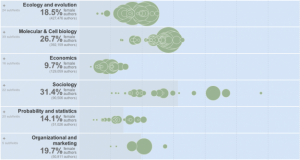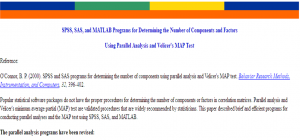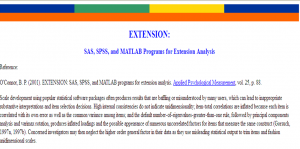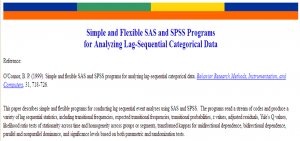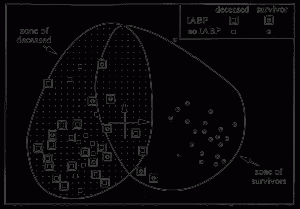Women as Academic Authors, 1665-2010
Posted by Armando Brito Mendes | Filed under estatística, visualização
The Chronicle of Higher Education has a look at the percentage of academic papers published by women, over the past five centuries.
The articles and authors described in this data were drawn from the corpus of JSTOR, a digital archive of scholarly papers, by researchers at the Eigenfactor Project at the University of Washington. About two million articles, representing 1765 fields and sub-fields, were examined, spanning a period from 1665 to 2011. The data are presented here for three time periods, the latest one ending in 2010, and a view that combines all periods.
Percentage of female authors is on the horizontal, and each bubble is a subfield sized by total number of authors. The graphic starts with publishing for all years, but be sure to click on the tabs for each time span to see changes.
The data is based on the archive of about two million articles from JSTOR, and a hierarchical map equation method is used to determine subfields.
The gender classification they used for names seems like it could be nifty for some applications. Gender is inferred by comparing names against the ones kept by the U.S. Social Security Administration, which includes gender. If a name was used for female at least 95 percent of the time, it was classified as a female name, and the same was done with male. Anything ambiguous was not included in the study
Tags: análise de dados, captura de conhecimento, data mining, Estat Descritiva
Advanced Statistics
Posted by Armando Brito Mendes | Filed under estatística, materiais ensino, software, visualização

Bons slides e outros materiais sobre clusters, AFE, SEM, reg logistica, meta-análise, MANOVA, Reliability
Welcome to Malbowges, the part of Nether Hell dominated by thieves, counsellors of Fraud (or should that just be counsellors), falsifiers and sowers of discord. It’s not a nice place for Sunday lunch. You must wade through rivers of Lucifer’s sputum to reach the answers you seek, and when you find those answers, you’ll probably wish you hadn’t bothered. Revenge is mine, ah ha ha, yah ha ha, ya ha ha ha ha ha ha ha ha ha …
Tags: captura de conhecimento, data mining, decisão médica, IBM SPSS Statistics, inferência, software estatístico
Introductory Statistics
Posted by Armando Brito Mendes | Filed under estatística, materiais ensino, videos, visualização
Welcome to Limbo, where the lustful, gluttonous and wrathful wander in endless torment. Here you can uncover the searing agony of SPSS, the stomach churning fear of central tendency and the rancid bile of z-scores. Good luck, you’ll need it.
Tags: análise de dados, captura de conhecimento, data mining, decisão médica, Estat Descritiva, IBM SPSS Statistics, inferência, inquéritos, software estatístico
Intermediate Statistics
Posted by Armando Brito Mendes | Filed under estatística, materiais ensino, software, videos
Welcome to the wood of suicides (is anyone getting all these Dante references or am I just wasting my time here?), where self flagellation is the name of the game. You will experience the bowel-evacuating effect of multiple regression, the bone-splintering power of ANOVA and the nose-hair pulling torment of factor analysis. Can you cope: I think not, mortal filth. Be warned, your brain will be placed in a jar of cerebral fluid and I will toy with it at my leisure.
Tags: decisão médica, IBM SPSS Statistics, inferência, software estatístico
PANDA – Practical Analysis of Nutritional Data
Posted by Armando Brito Mendes | Filed under estatística, materiais ensino, software, visualização
Chapter 1 – USING NUTRITIONAL DATA
Chapter 2 – DATA CLEANING
Chapter 3 – ONE-WAY ANALYSIS
Chapter 4 – TWO-WAY ANALYSIS
Chapter 5 – MULTI-WAY ANALYSIS
Chapter 6 – SUBMODULES
Chapter 7 – ASSESS YOUR UNDERSTANDING
Chapter 8 – KENYA REAL WORLD ANALYSIS
Building and presenting a situation analysis
Child Feeding Practices
Tags: análise de dados, decisão médica, Estat Descritiva, IBM SPSS Statistics, inferência, software estatístico
Determining the Number of Components and Factors Using Parallel Analysis and Velicer’s MAP Test
Posted by Armando Brito Mendes | Filed under estatística, software, visualização
Popular statistical software packages do not have the proper procedures for determining the number of components or factors in correlation matrices. Parallel analysis and Velicer’s minimum average partial (MAP) test are validated procedures that are widely recommended by statisticians. This paper described brief and efficient programs for conducting parallel analyses and the MAP test using SPSS, SAS, and MATLAB.
Scale development using popular statistical software packages often produces results that are baffling or misunderstood by many users, which can lead to inappropriate substantive interpretations and item selection decisions. High internal consistencies do not indicate unidimensionality; item-total correlations are inflated because each item is correlated with its own error as well as the common variance among items; and the default number-of-eigenvalues-greater-than-one rule, followed by principal components analysis and varimax rotation, produces inflated loadings and the possible appearance of numerous uncorrelated factors for items that measure the same construct (Gorsuch, 1997a, 1997b). Concerned investigators may then neglect the higher order general factor in their data as they use misleading statistical output to trim items and fashion unidimensional scales.
These problems can be circumvented in exploratory factor analysis by using more appropriate factor analytic procedures and by using extension analysis as the basis for adding items to scales. Extension analysis provides correlations between nonfactored items and the factors that exist in a set of core items. The extension item correlations are then used to decide which factor, if any, a prospective item belongs to. The decisions are unbiased because factors are defined without being influenced by the extension items. One can also examine correlations between extension items and any higher order factor(s) in the core items. The end result is a comprehensive, undisturbed, and informative picture of the correlational structure that exists in a set of core items and of the potential contribution and location of additional items to the structure.
Tags: análise de dados, captura de conhecimento, decisão médica, desnvolvimento de software, IBM SPSS Statistics, software estatístico
SPSS Programs for Analyzing Lag-Sequential Categorical Data
Posted by Armando Brito Mendes | Filed under estatística, materiais ensino, software
This paper describes simple and flexible programs for conducting lag sequential event analyses using SAS and SPSS. The programs read a stream of codes and produce a variety of lag sequential statistics, including transitional frequencies, expected transitional frequencies, transitional probabilities, z values, adjusted residuals, Yule’s Q values, likelihood ratio tests of stationarity across time and homogeneity across groups or segments, transformed kappas for unidirectional dependence, bidirectional dependence, parallel and nonparallel dominance, and significance levels based on both parametric and randomization tests.
Tags: captura de conhecimento, data mining, desnvolvimento de software, IBM SPSS Statistics, previsão, qualidade, software estatístico
Correspondence Analysis
Posted by Armando Brito Mendes | Filed under estatística
| 1. Introduction 2. Overview of the Method 5. What you Find in the Output and How to Use it 6. Graphical Representations and Interpretation 8. Bibliography |
Tags: análise de dados, inferência
Logistic regression and discriminant analysis
Posted by Armando Brito Mendes | Filed under estatística, materiais ensino, software
Contents of this handout: The problem of dichotomous dependent variables; Discriminant analysis; Logistic regression – theory; Logistic regression (and discriminant analysis) in practice; Interpreting and reporting logistic regression results; References and further reading; Examples.
Tags: IBM SPSS Statistics, inferência, software estatístico
Analysis Of Categorical Dependent Variables
Posted by Armando Brito Mendes | Filed under estatística, materiais ensino, software
- Models for Binary Outcomes
- Models for Multiple Outcomes
Tags: IBM SPSS Statistics, inferência
